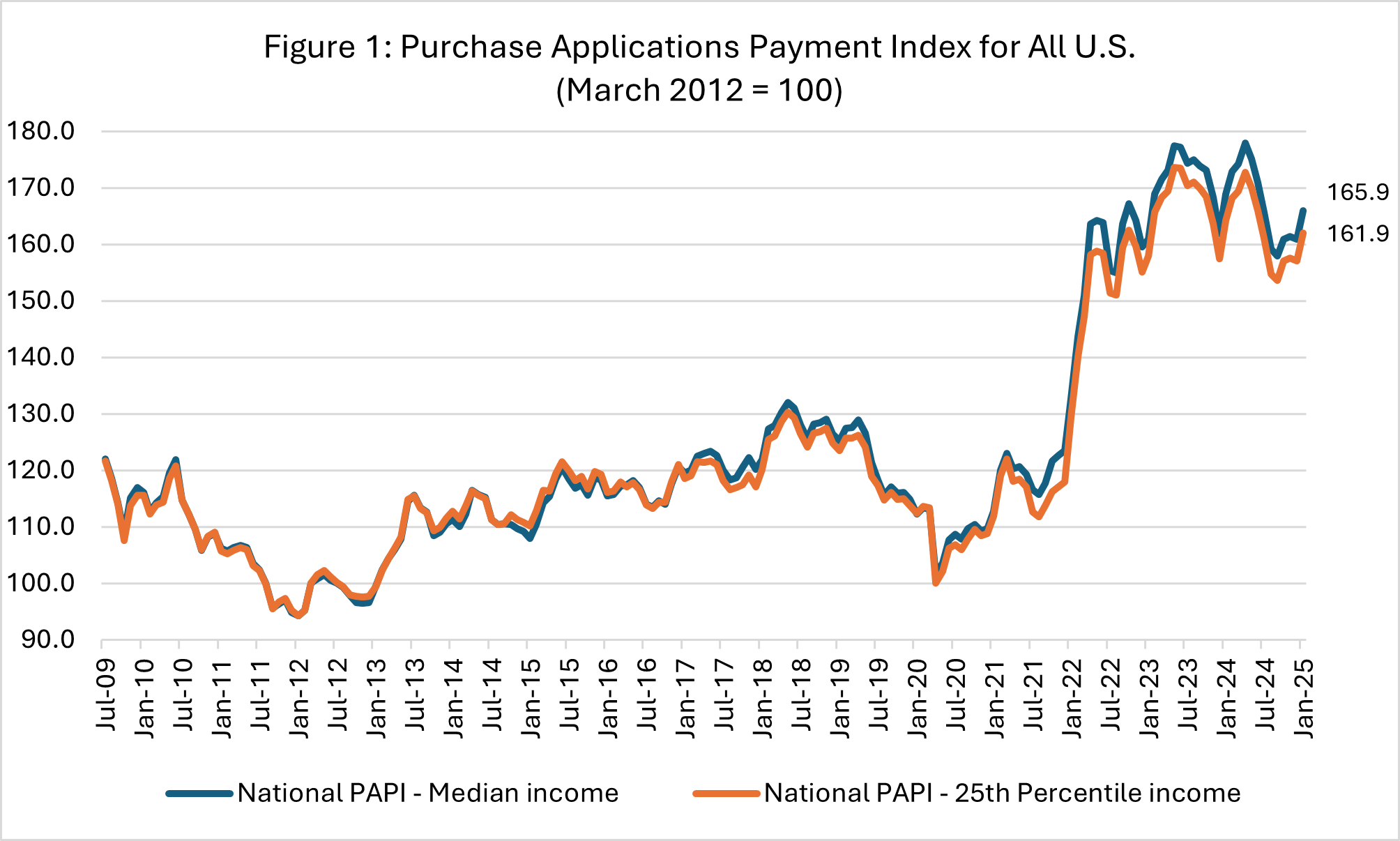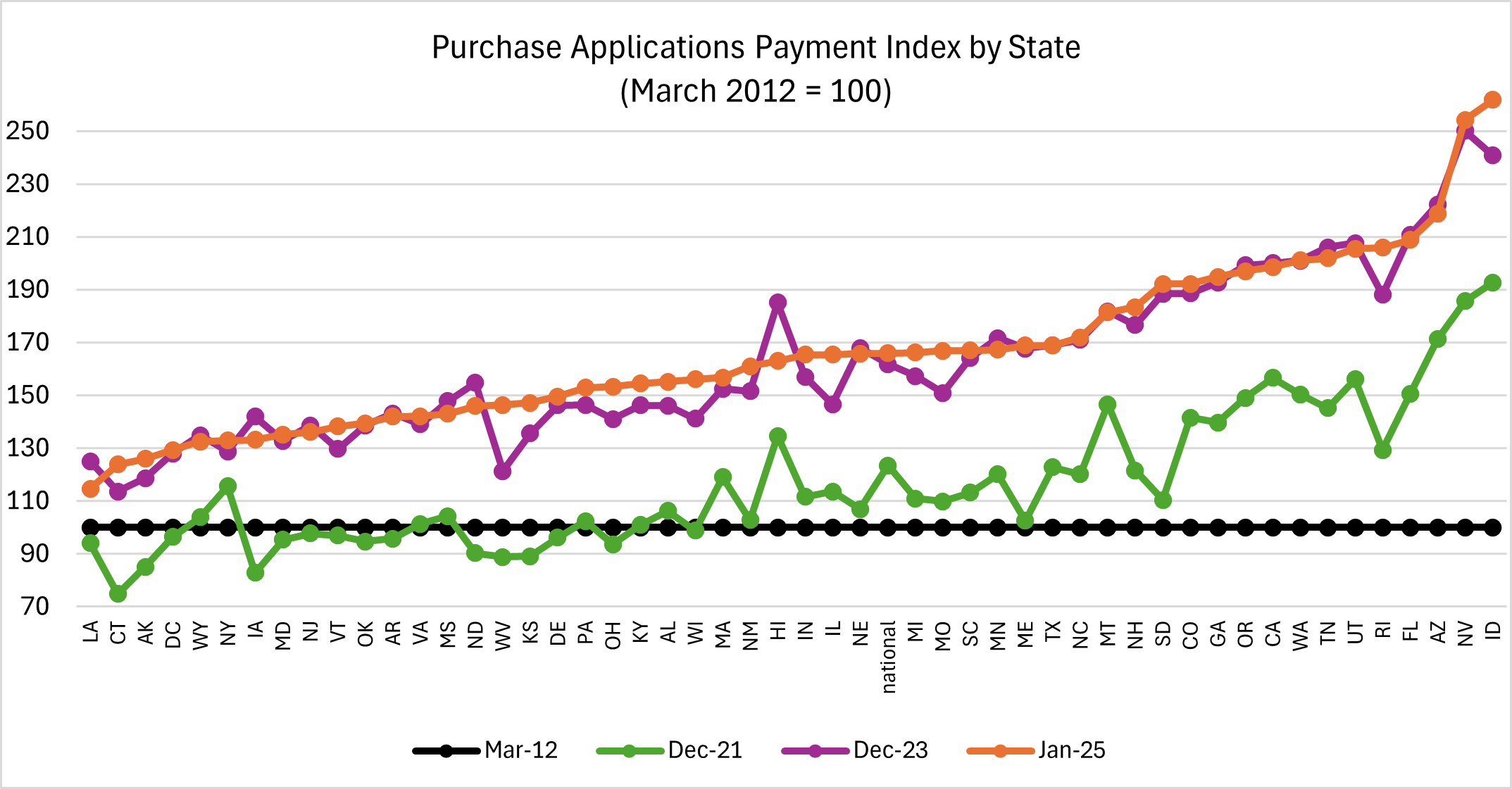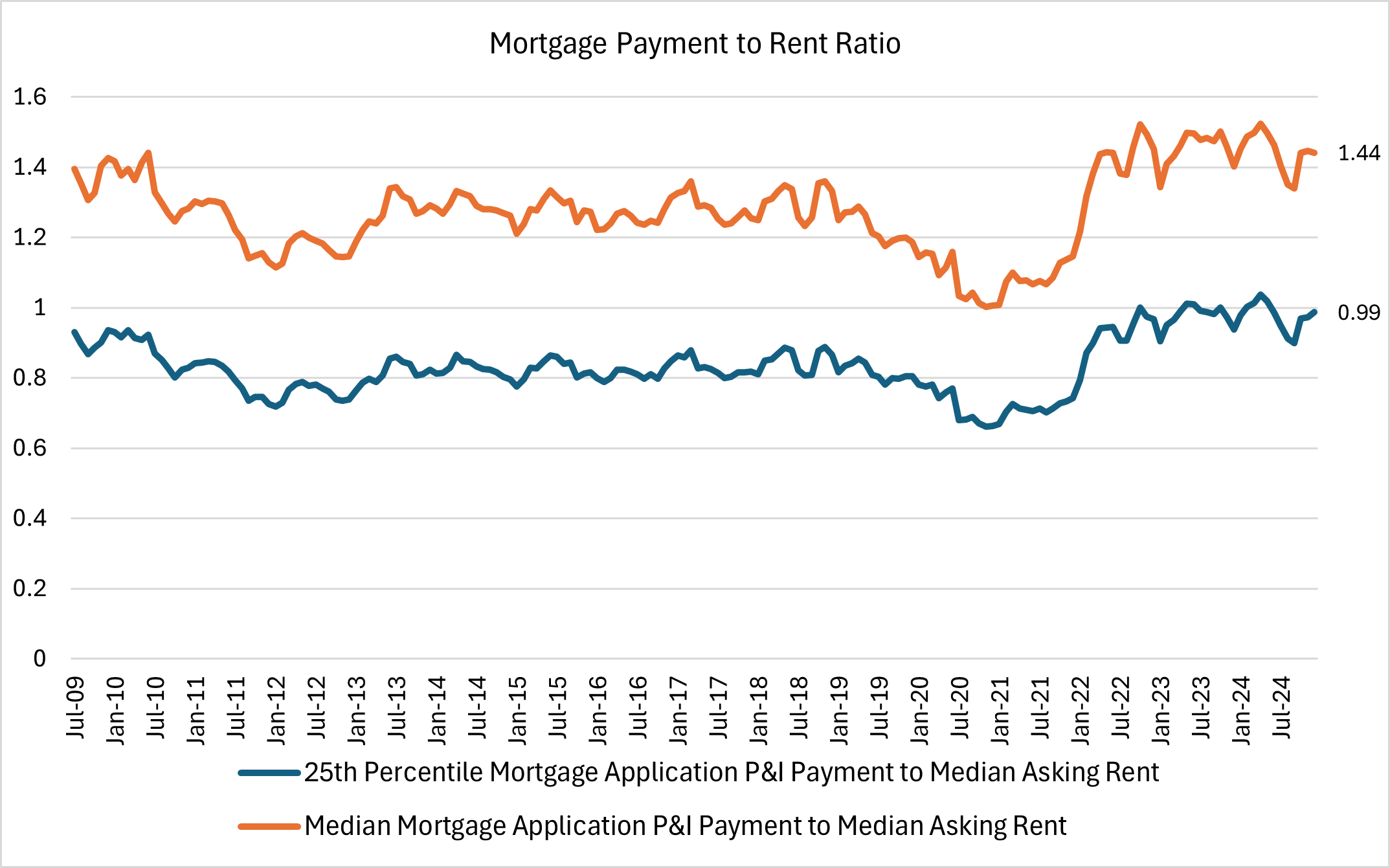Mortgage Application Payments Increased 3.7 Percent to $2,205 in January
February 27, 2025
Share to
WASHINGTON, D.C. (February 27, 2025) – Homebuyer affordability declined in January, with the national median payment applied for by purchase applicants increasing to $2,205 from $2,127 in December. This is according to the Mortgage Bankers Association's (MBA) Purchase Applications Payment Index (PAPI), which measures how new monthly mortgage payments vary across time – relative to income – using data from MBA’s Weekly Applications Survey (WAS).
“Homebuyer affordability conditions declined further in January as volatile mortgage rates and high home prices continue to impact many prospective buyers’ purchasing power,” said Edward Seiler, MBA’s Associate Vice President, Housing Economics, and Executive Director, Research Institute for Housing America. “Even with persisting affordability challenges, MBA is forecasting for a small increase in purchase originations in 2025, with activity increasing 16% to $2.1 trillion.”
The national PAPI index indicates that new home affordability increased in January. Interest rates were up 18 bps from December (and 24 bps from January 2024). The median purchase application amount increased from $319,000 to $324,800. Taken together, we had a 3.1-point increase in PAPI. The increase in PAPI was felt in 40 states.
An increase in MBA’s PAPI – indicative of declining borrower affordability conditions – means that the mortgage payment to income ratio (PIR) is higher due to increasing application loan amounts, rising mortgage rates, or a decrease in earnings. A decrease in the PAPI – indicative of improving borrower affordability conditions – occurs when loan application amounts decrease, mortgage rates decrease, or earnings increase.
The national PAPI (Figure 1) increased 3.1 percent to 165.9 in January from 160.8 in December. Median earnings were up 5.2 percent compared to one year ago, and while payments increased 3.3 percent, the significant earnings growth means that the PAPI is down 1.8 percent on an annual basis. For borrowers applying for lower-payment mortgages (the 25th percentile), the national mortgage payment increased to $1,519 in January from $1,456 in December.
MBA’s national mortgage payment to rent ratio (MPRR) increased from 1.34 at the end of the third quarter (September 2024) to 1.44 at the end of the third quarter (December 2024), meaning mortgage payments for home purchases have increased relative to rents. The Census Bureau’s HVS national median asking rent in fourth-quarter 2024 decreased to $1,475 ($1,523 in third-quarter 2024). The 25th percentile mortgage application payment to median asking rent ratio increased to 0.99 in December (0.90 in September 2024).
The Builders’ Purchase Application Payment Index (BPAPI) showed that the median mortgage payment for purchase mortgages from MBA’s Builder Application Survey increased to $2,531 in January from $2,500 in in December.
Additional Key Findings of MBA's Purchase Applications Payment Index (PAPI) – January 2025
- The national median mortgage payment was $2,205 in January—up $78 from December. It is up by $71 from one year ago, equal to a 3.3% increase.
- The national median mortgage payment for FHA loan applicants was $1,934 in January, up from $1,866 in December and up from $1,830 in January 2024.
- The national median mortgage payment for conventional loan applicants was $2,225, up from $2,128 in December and up from $2,053 in January 2024.
- The top five states with the highest PAPI were: Idaho (261.8), Nevada (254.3), Arizona (218.7), Florida (208.9), and Rhode Island (205.9).
- The top five states with the lowest PAPI were: Louisiana (114.6), Connecticut (123.8), Alaska (125.9), Washington, D.C. (129.2), and Wyoming (132.5).
- Homebuyer affordability decreased for Black households, with the national PAPI increasing from 152.2 in December to 157.0 in January.
- Homebuyer affordability decreased for Hispanic households, with the national PAPI increasing from 153.6 in December to 158.5 in January.
- Homebuyer affordability decreased for White households, with the national PAPI increasing from 163.8 in December to 168.9 in January.



About MBA’s Purchase Applications Payment Index
The Mortgage Bankers Association’s Purchase Applications Payment Index (PAPI) measures how new mortgage payments vary across time relative to income. Higher index values indicate that the mortgage payment to income ratio (PIR) is higher than in a month where the index is lower. Contrary to other affordability indexes that make multiple assumptions about mortgage underwriting criteria to estimate mortgage payment level, PAPI directly uses MBA’s Weekly Applications Survey (WAS) data to calculate mortgage payments.
PAPI uses usual weekly earnings data from the U.S. Bureau of Labor Statistics’ Current Population Survey (CPS). Usual weekly earnings represent full-time wage and salary earnings before taxes and other deductions and include any overtime pay, commissions, or tips usually received. Note that data are not seasonally adjusted.
MBA’s Builders’ Purchase Application Payment Index (BPAPI) uses MBA’s Builder Application Survey (BAS) data to create an index that measures how new mortgage payments vary across time relative to income, with a focus exclusively on newly built single-family homes. As with PAPI, higher index values indicate that the mortgage payment to income ratio (PIR) is higher than in a month where the index is lower. To create BPAPI, principal and interest payment amounts are deflated by the same earnings series as in PAPI.
The rent data series calculated for MBA’s national mortgage payment to rent ratio (MPRR) comes from the U.S. Census Bureau’s Housing Vacancies and Homeownership (HVS) survey’s median asking rent. The HVS data is quarterly, and as such, the mortgage payment to rent ratio will be updated quarterly. The HVS data is quarterly, and as such, the mortgage payment to rent ratio will be updated quarterly.
For additional information on MBA’s Purchase Applications Payment Index, click here.
